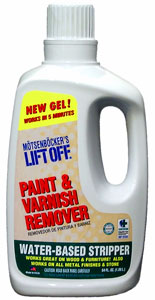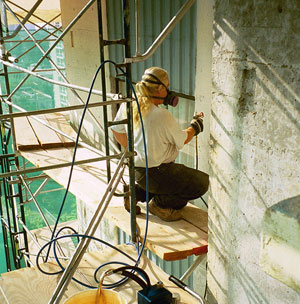
Technology:
Eco-friendly Paint Strippers
They may require more patience, but� biodegradable paint removers get the job done.
by Jeff Woodard
priority list these days. Saving the environment is also a primary concern. Manufacturers are working to develop safe, biodegradable paint removers that work quickly and effectively. But is it always possible? Defining the qualities of a biodegradable stripper and determining safe, speedy application techniques pose many challenges.
Most biodegradable paint strippers will be based on one of the following chemicals: dibasic esters, N-methyl pyrrolidone, caustic soda, benzyl alcohol, hydrogen peroxide or sodium metasilicate, according to Drew Gagnier, vice president of Hero Products Group of Vancouver, B.C., a manufacturer of paint equipment products that is closely associated with Napier Environmental Technology. "Non-biodegradable paint strippers are based primarily on methylene chloride, xylene and toulene. These are the traditional types of strippers."
Various brands may comprise any combination of biodegradable and non-biodegradable strippers, Gagnier says, noting that strippers formulated for exterior purposes are usually based in caustic soda, sodium metasilicate or benzyl alcohol. "This is because they emulsify the exterior paint and are easily rinsed with water."
Many safe strippers are soy-based. They are not harmful but carry a negative stigma due to their time-consuming nature, says Skip Motsenbocker, owner of Motsenbocker's Lift Off in San Diego. "You can safely put your hand in them. They work on an air-lock principal, and most will take one to three days to work. "A few work in as little as 15 minutes, but Lift Off works the fastest, he claims. "Whether used on metal, stone, wood or whatever, Lift Off is going to penetrate through all layers of coatings to the natural surface in five minutes."
 According to Motsenbocker, extensive testing has shown that Lift Off is the only environmentally safe stripper that breaks the molecular bond from the surface without melting or dissolving the coating. Lift Off holds two patents — one is based on the formula's unique design, the other on how the chemistry actually works. "Ours is the only safe stripper with Green Cross certification from Scientific Certification Systems (SCS)," he says. According to Motsenbocker, extensive testing has shown that Lift Off is the only environmentally safe stripper that breaks the molecular bond from the surface without melting or dissolving the coating. Lift Off holds two patents — one is based on the formula's unique design, the other on how the chemistry actually works. "Ours is the only safe stripper with Green Cross certification from Scientific Certification Systems (SCS)," he says.
Napier Environmental Technology also features a line of strippers — the RemovALL line — that break the bond between paint and surface. Based on benzyl alcohol and hydrogen peroxide, these strippers are based on Selective Adhesive Removal Agent (SARA) technology. "They penetrate the coating without emulsifying the paint and lift it off the surface by breaking the bond," says Gagnier. "This reduces the amount of clean-up required, as the end product is only hardened paint chips. This stripper is also non-toxic and non-corrosive. It is environmentally friendly, biodegradable and contains no hazardous air pollutants."
The safer, biodegradable strippers often take longer to work than their more caustic counterparts, but there is good reason, according to Janice Nachbar, national sales manager for Back To Nature in Englishtown, N.J. "Most of the biodegradable strippers on the market are designed to remove multiple layers of paint and other coatings. Stripping works through evaporation. The safer products evaporate more slowly, therefore removing more paint in one [application].
 Environmentally friendly strippers generally dry at a slower pace, allowing for more thorough stripping time, agrees Gagnier. He adds that non-environmentally friendly strippers such as methylene chloride work more quickly — but there is a downside. "Since they dry faster, they can make it very difficult to remove paint. Ultimately the job might take longer. "Other advantages of environmentally friendly strippers are that they do not emit hazardous fumes and can be applied in a variety of ways. Environmentally friendly strippers generally dry at a slower pace, allowing for more thorough stripping time, agrees Gagnier. He adds that non-environmentally friendly strippers such as methylene chloride work more quickly — but there is a downside. "Since they dry faster, they can make it very difficult to remove paint. Ultimately the job might take longer. "Other advantages of environmentally friendly strippers are that they do not emit hazardous fumes and can be applied in a variety of ways.
"Our products can be brushed, rolled or sprayed with an airless sprayer," says Nachbar, referring to Back To Nature's Ready-Strip line. "There are other products on the market that can be applied only by spraying, some by using a heavy-duty pump and others only by brushing. "While spraying, pouring, rolling, troweling and brushing are options for various applications, Motsenbocker and Gagnier caution against spraying or troweling methylene chloride.
 When applying any strippers, it is best to cover nearby vegetation or concrete. "Not all environmentally safe or biodegradable products are safe to use around plants," notes Nachbar. "Milder strippers can be rinsed off plants with no damage, provided it is done promptly. "While Gagnier recommends pre-wetting vegetation if using caustic, soda-based strippers, Motsenbocker says the use of Lift Off will help plants withstand any residue washed into the ground. Concrete poses its own dilemma, says Motsenbocker. "If you are using a solvent-based stripper and the paint chips fall to the concrete, the paint re-adheres. If that happens, how are you going to safely strip the concrete? With Lift Off, plants and concrete don't have to be covered." When applying any strippers, it is best to cover nearby vegetation or concrete. "Not all environmentally safe or biodegradable products are safe to use around plants," notes Nachbar. "Milder strippers can be rinsed off plants with no damage, provided it is done promptly. "While Gagnier recommends pre-wetting vegetation if using caustic, soda-based strippers, Motsenbocker says the use of Lift Off will help plants withstand any residue washed into the ground. Concrete poses its own dilemma, says Motsenbocker. "If you are using a solvent-based stripper and the paint chips fall to the concrete, the paint re-adheres. If that happens, how are you going to safely strip the concrete? With Lift Off, plants and concrete don't have to be covered."

|

